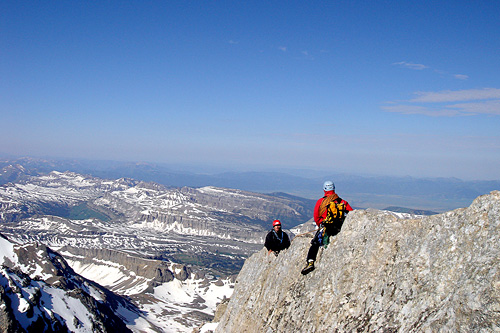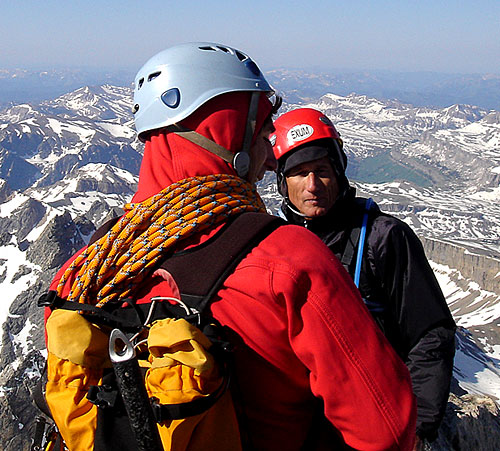
|
Dolph Tillotson, left, and Christian Santelices negotiate the Horse, a rock wall with few holds and terrifying exposure. Saturday, July 9 (Summit Day)
Before 3 a.m., someone turned on the gas jet to boil water for breakfast. At 3 a.m. sharp, one of the guides lit the lantern. We emerged from sleeping bags, and I slipped on my Vasque boots and stepped out into the cold darkness. The stars at that altitude were brilliant. The Big Dipper seemed close enough to touch. The North Star shone high above it, nearly obscured by the spire of The Grand. As we geared up for the climb, I noticed again Tom's persistent cough. “Hey, Tom, that doesn't sound so good,” I said. “How are you feeling?” “It's not good,” he said, “and I feel like shit.” His face looked drawn and tired. Altitude sickness is mysterious in its origins and mysterious in whom it strikes.
Our group of six made it to the top of Kilimanjaro, over 19,000 feet, with few symptoms. Here, at just under 12,000 feet, Tom clearly suffered. Of the six of us, Tom is perhaps the strongest, yet he had most of the warning signs of the illness - coughing, loss of appetite, dizziness and nausea. In severe cases, simple altitude sickness can become High Altitude Pulmonary Edema (HAPE). If untreated, extreme cases can lead to serious illness, brain damage or even death. The only effective treatment is to get the climber to lower altitudes. However, on Summit Day, early in the morning of July 9, Tom Kimbrough still felt he might be able to make the summit. Bravely, he suited up and prepared to climb. We put on helmets, harnesses and headlamps and filed out of camp in the dark at about 4:10 a.m. Mark said our first stop would be at a large, dark rock formation called the Black Dike. “At that point, if everyone's feeling OK, we'll go on,” he said. “But if anyone has a problem like altitude sickness, you can choose to walk down from there. The Black Dike is the last point where you can come down from the mountain without a guide to escort you.” For the summit attempt, Exum provided two additional guides, Chris Bassett and an unpaid apprentice, Eric Knoff. Our six climbers and four guides set off up the mountain in two groups Jim, Richard and I were in the lead, followed by Harry, Brent and Tom. As we climbed, the distance between the two groups widened, and the sound of Tom's coughing receded. When we stopped at the Black Dike, our group had to wait several minutes before the trailing group caught up. We marked their progress by the sound of Tom's awful cough. “It really wasn't a choice,” Tom said later. “I just couldn't go on. I couldn't get my breath - I felt breathless every second. Also, I was nauseous, and I was very dizzy. I couldn't get my balance.” Brent and Harry supported Tom in his decision to return to base. He headed back down the mountain to base where he rested and later started back down the long trail. Tom told us that soon after starting down, his symptoms began to dissipate. The remaining five us of roped up and began the real climbing of the day. We proceeded around a rock formation called the Needle and up a couloir. We came to a series of narrow chimneys that we climbed, belaying each other as we went. We came to two pitches called the Belly Roll and the Crawl. The Belly Roll features a blind step around a big rock, and both feature dizzying exposure several thousand feet straight down to rock below. Once climbers negotiate those passages, they are near the summit. There remains a series of easy pitches and then Sargent's Chimney. We climbed through it, knowing we were very near the top. Jim and I watched as Richard proceeded to the summit with Eric. Christian moved left and right, peered around a rock wall and then turned back to us. “You guys are going to get a bonus,” he said. “You're going to do the Horse.” After nearly five hours of hard climbing, Jim and I wanted no bonus. The Horse - our last pitch - actually is the end point of he Exum Route. Climbers must work their way up a rock wall with few holds and terrifying exposure. You reach a narrow ridge and straddle it - literally like a horse. The mountain falls away sharply on either side. Jim and I were more desperate than thrilled with that skinny sliver of granite. We inched along it about 180 feet and then - an easy walk up to the summit. We joined Richard, already there and sitting down, admiring the view. It was just after 9:30 a.m. We had made the final ascent in a bit over five hours. A few minutes later, Harry and Brent joined us. We slapped five, took pictures, rested. Within 20 minutes, we started down. Pitch by pitch, we slowly down-climbed the mountain, belayed from above as we went. It was slow, painstaking work. Eventually, we came to a rappel point and rappelled down to one of the lower snowfields. Within three hours, we were back at the Black Dike. An hour or so later, all five of us were back in camp. I was both exhausted and famished, so tired I could barely speak. Christian reminded us we had to head out soon. We wearily re-loaded our packs and prepared to head out just after 1 p.m. First stop was at the spring below camp where we refilled water containers. Soon after, we once again came to the snowfield. It was there we had one of the most exciting moments of the trip. Christian roped us up before entering the snow and suggested we get down by means of a butt glissade. That's pretty much what it sounds like. You slide down the snow on your butt, feet in front, theoretically controlling your speed with your ice axe. Jim and I went first with me in front. We quickly gathered speed - too much speed. What happened next occurred so quickly it was impossible to predict or avoid. On our right, there was a huge rock wall. The rock had absorbed enough heat from the sun over the past few days so that a large fissure melted in the snow around it. The fissure spread into the path of our glissade, but we could not see it until it was too late. I hoped our speed would carry us over the trench. Instead, it whipped us suddenly to the right into the wedge shaped, man-sized crack between rock and snow. The top of my head was several feet underneath the top level of the snow, and I was buried up to my shoulders in tightly packed snow. I couldn't move. Looking ahead of me, down into the fissure, I realized it extended farther down into darkness. “Don't move, Jim,” I said. “This crack goes quite a ways down, and I don't want to go in any further.” Christian and Erik arrived, freed Jim first and secured the rope. I then could stand up and get a boost out of the crack. |
By Dolph Tillotson
Climbing Teton
1 - Just Have Fun
2 - The Climbers
3 - Tuesday
4 - Wednesday
5 - Thursday
6 - Friday
7 - Summit Day 8 - Time is Short The relationships are more important than the climb. Resources See also |
© 2005 The Galveston County Daily News. All rights reserved. A Galveston Newspapers Inc. Publication. |


